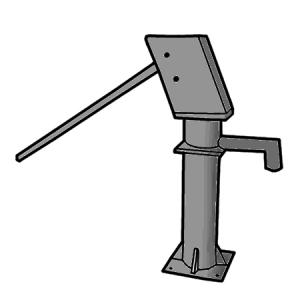Hand pumps are water-lifting devices that can be operated manually to withdraw water from surface water sources, groundwater sources and reservoirs, or to pump water into distribution systems. They are relatively easy to install, simple to operate and capable of lifting adequate amounts of water for a small community from depths up to 80 metres. They are widely used in places where access to power sources is constrained, where financial resources for investment are limited, and where domestic water requirement is not excessive. Many different pump models including low-cost options are available and suit most local conditions. However, operation and maintenance requires community involvement, especially if the pumps are used heavily.
| In | Out |
|---|---|
Freshwater, Drinking Water |
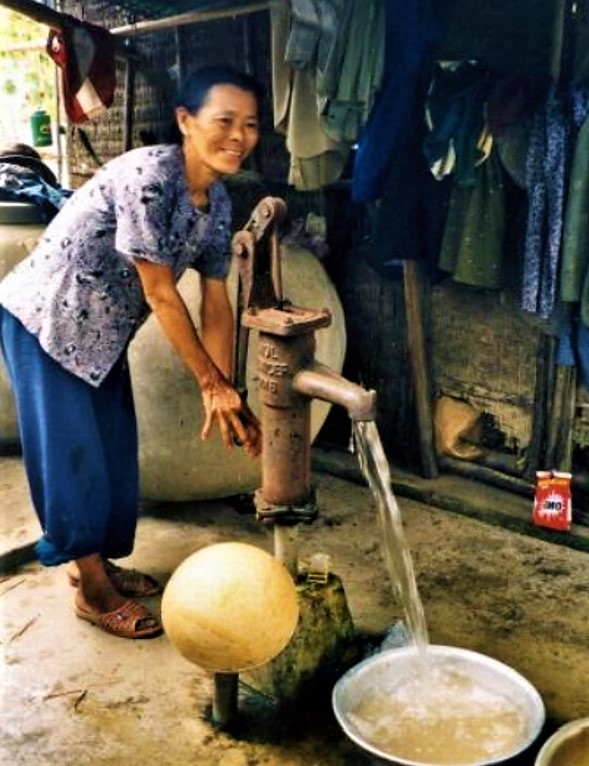
Water-lifting devices are used to withdraw water from surface water sources (lakes, rivers or reservoirs), groundwater sources (hand dug wells or drilled wells) and underground reservoirs, or to pump water into distribution or irrigation systems.
Hand pumps (also named manual pumps or human-powered pumps) are a type of water-lifting device mainly serving community water supplies that can be operated manually. Human-powered pumps also include foot pumps (HOLDEN & SWANEPOEL 2004) and rope and bucket systems with or without a windlass or shadouf (OLLEY 2008).
Various other forms of lifting devices with external power sources exist: animal, wind and solar powered pumps as well as electric and diesel pumps.
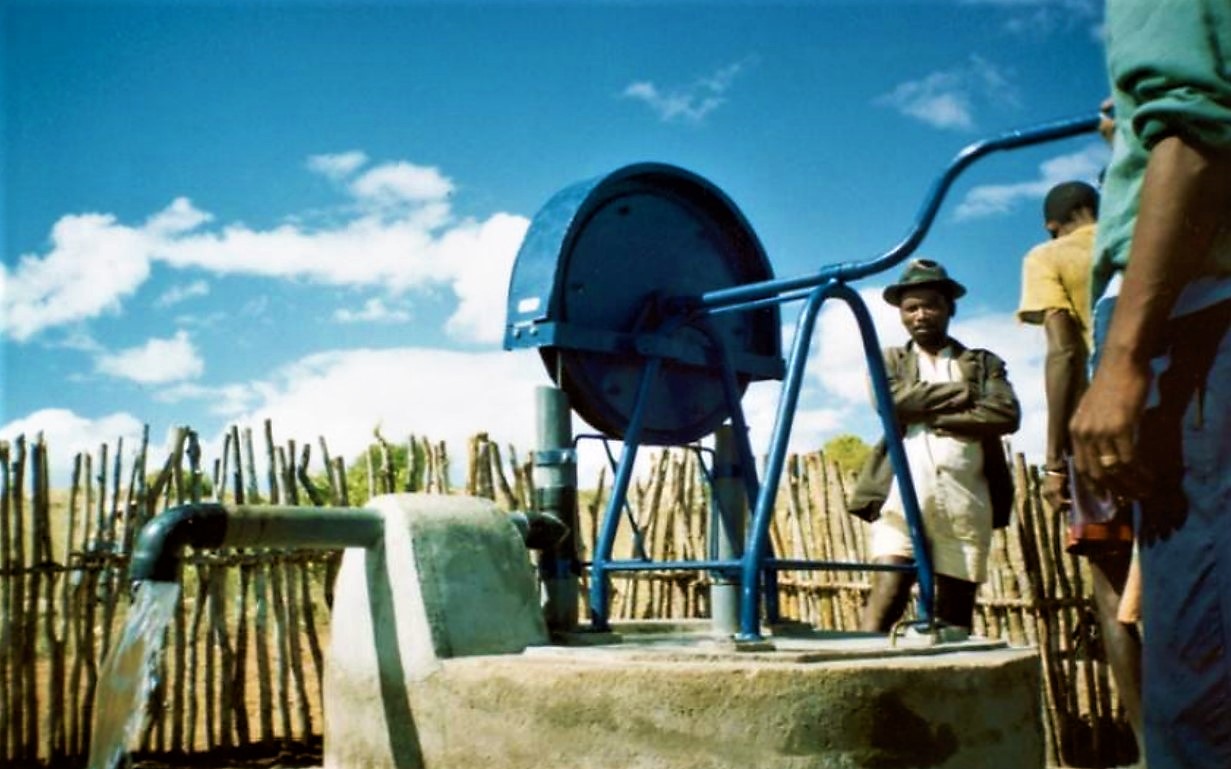
Human-powered pumps are capable of lifting relatively small amounts of water from depths of up to 100 m. They are widely used in places where access to power sources is limited, where financial resources for investment are constrained, and where domestic water requirements are not excessive. Additionally, they are relatively easy to install and rather simple to operate, making them one of the most commonly used and promising water-lifting technologies for rural areas in developing countries (OLLEY 2008).
Human-powered pumps have the potential to improve a community’s local water management system and hence its livelihood significantly. In terms of drinking water supply, hand pumps provide faster, easier and safer access compared to lifting devices with rope and bucket. In terms of irrigation, hand (or foot) pumps can significantly increase agricultural yields: not being dependent on hiring costly and heavy diesel pumps, farmers can irrigate independently whenever optimal for the crops. Equally, women, children and small farmers are empowered (see also gender issues).
On the downside, human-powered pump systems often failed due to a lack of community involvement and adequate maintenance, and due to installation of pumps that were not suitable for heavy usage. The broad recognition of this fact lead to simple low-cost pumping systems (VLOM pumps), which can be operated and maintained by a local community without external assistance, and to the awareness of the importance of community participation in the planning of the pump project from the very beginning and the indispensability of management of maintenance (SKINNER & SHAW n.y.).
Establishing a human-powered pump-based water supply system requires a thorough analysis. When selecting the pump system, a wide range of options should be carefully considered in order to choose the optimal long-term solution. Consult OLLEY (2008): Human-powered Hand-Pumps for Water Lifting (pp.1-2) for a full list of criteria and key questions to answer before selecting pumps.
Until today, hundreds of different human-powered pump systems have been developed based on several mechanical principles. Human-powered pumps make use of one single or a combination of those principles. (BAUMANN 2000):
- Direct lift: Water is physically lifted in a container. E.g. rope and bucket, bailer, Persian wheel.
- Displacement: Water is incompressible. Hence, it can be pushed or displaced (reciprocating technique). E.g. piston pumps, rope pumps, progressive cavity pumps, diaphragm pumps.
- Creating a velocity head: Water can be propelled to a high speed. The momentum produced can be used either to create a pressure or a flow (Rotary technique). E.g. helical rotor, propeller pumps, centrifugal pumps, rebound inertia pumps, jet pumps.
Human-powered pump systems are often categorised in shallow-well (up to 7 metres) and deep-well pumps (above 7 metres).
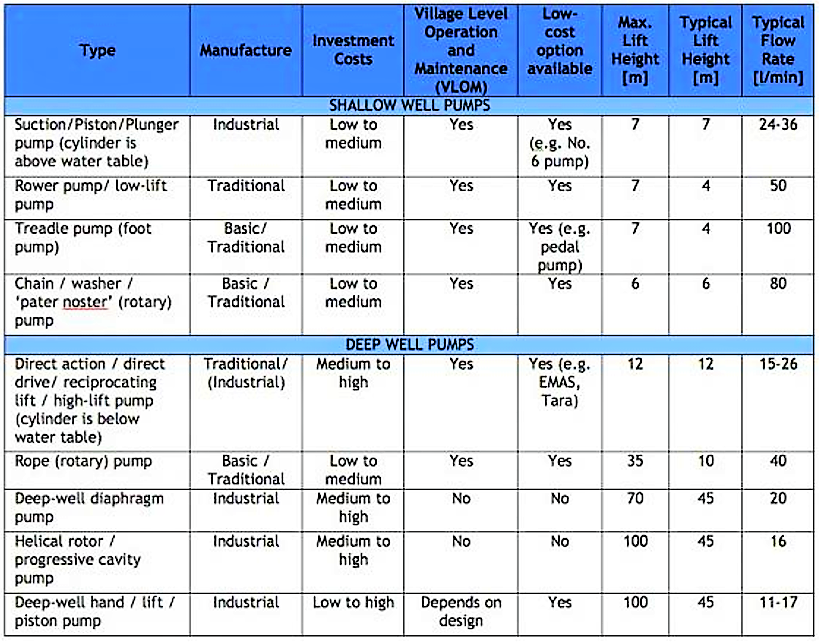
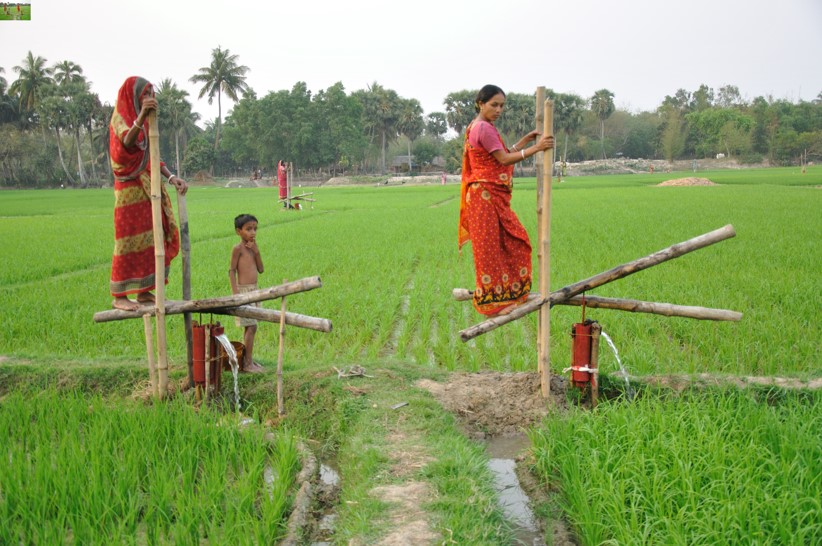
Based on these human-powered pump types, many different pump models, sub-types and variations are available. All of them have different characteristics (i.e. costs, O&M requirements, health aspects, etc.), and hence suit various different local conditions. For a detailed description of pump models, see MONTANEGRO et al. (2010). For agricultural purposes, many other forms of water-lifting devices exist (see also OLLEY (2008): Human- and Animal-powered Water Lifting Devices for Irrigation).
Capital costs for human-powered pumps are mainly associated with the purchase of the pump, installation, construction of the apron and drainage system, and fencing (HOLDEN & SWANEPOEL 2004). The costs for the pump strongly vary according to the chosen pump type and materials. For most pump types, low-cost options exist making use of locally available material and labour. See BAUMANN (2011): Low-cost Hand Pumps for a detailed description of specific low-cost pump models.
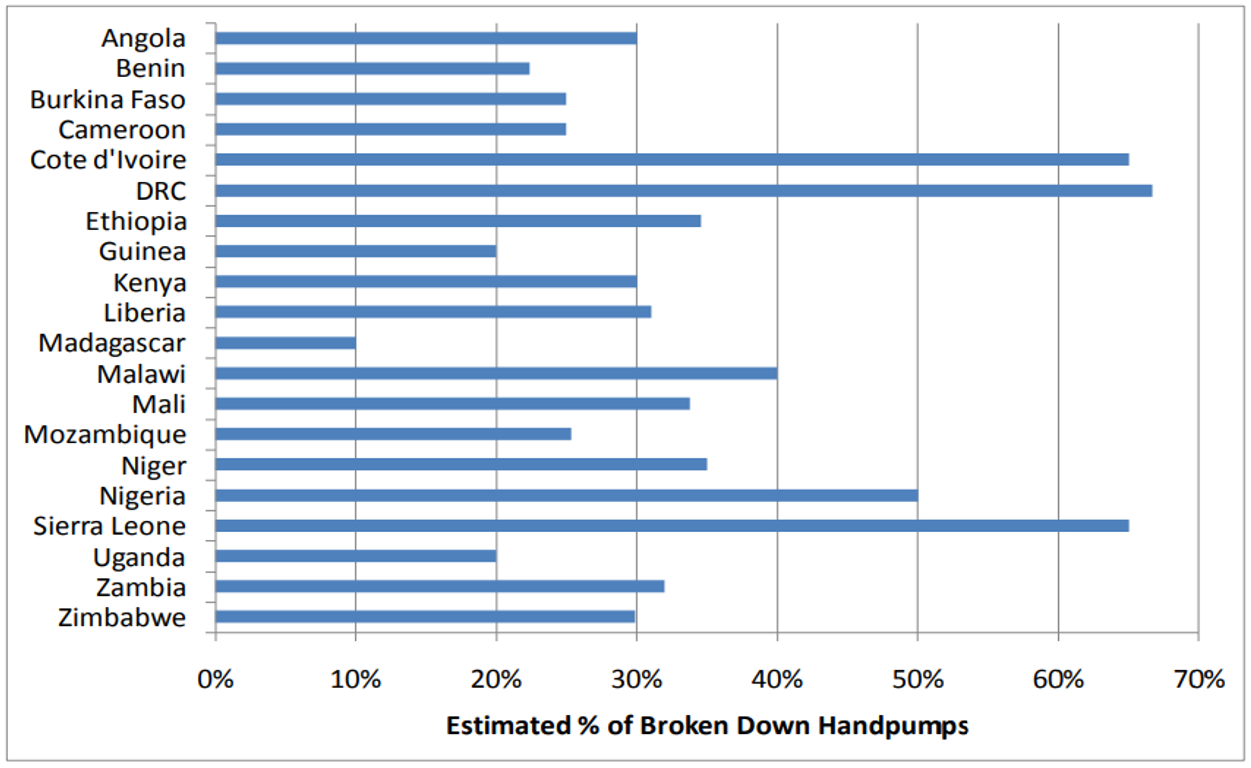
Data from a number of stakeholders in Africa show that many human-powered pumps are actually out of operation, although they were once considered to be robust and simple in maintenance. This represents a crisis of wasted infrastructure investment. The disturbing truth is that installed rural water supply infrastructure is often far harder to keep operational than expected and consequently fails due to poor maintenance before its planned design lifetime (RWSN 2010).
Constructing new water points instead of maintaining existing ones is hardly ever considered to be sustainable. The Rural Water Supply Network (RWSN) argues for the establishment of realistic, long term financial mechanisms and institutional support systems (see also financing (see PPT) and buidling an institutional framework), which can actually lead to adequate operation and maintenance in the long-run and, thus, to a sustainable rural water supply (RWSN 2010).
It can be argued, that in terms of improving water supply systems, external financial support should rather focus on capacity building than on (free) provision of materials and tools. Keeping in mind that self-purchased objects are better taken care of, the idea is to make people pay for water supply systems (see also water pricing and abstraction charges) instead of donating them. However, subsidising may be an option in some context if the project is well organised, implemented and monitored (see also government contributions). As single families frequently are incapable of affording an own well and pump, a form of financial management is required: cost sharing amongst a group of families or community based savings can both make for a sustainable water supply system and a better social cohesion. Alternatively, microfinance can also be an option.
Equally, user involvement during the implementation process (see also community action plan) and communal management of operation and maintenance is vital to enable long-term viability of human-powered pumps. An option for achieving this objective is to nominate a (paid) caretaker who carries out necessary physical tasks such as cleaning the area, lubricating moving parts, tightening bolts and nuts, monitoring the output rate and requesting help for major problems; yet, training of users on how to use the pump properly and general guidance in heath care issues should likewise be part of the caretaker’s remit (ELSON et al. n.y.).
As for physical maintenance, differing pump types will require a different level of attention and distinctive maintenance tasks (ELSON et al. n.y.). Detailed information on maintenance for the most common pumping systems is found in BRIKKE & BREDERO (2003).
Use of a pump for hand-dug wells brings significant improvement in terms of health. Sealing the opening with a concrete apron and the pump itself effectively prevents contamination from surface (see water source protection). However, some pump types (e.g. rope pumps) may need special attention regarding cleanness as the rope inevitably gets in contact with the outside.
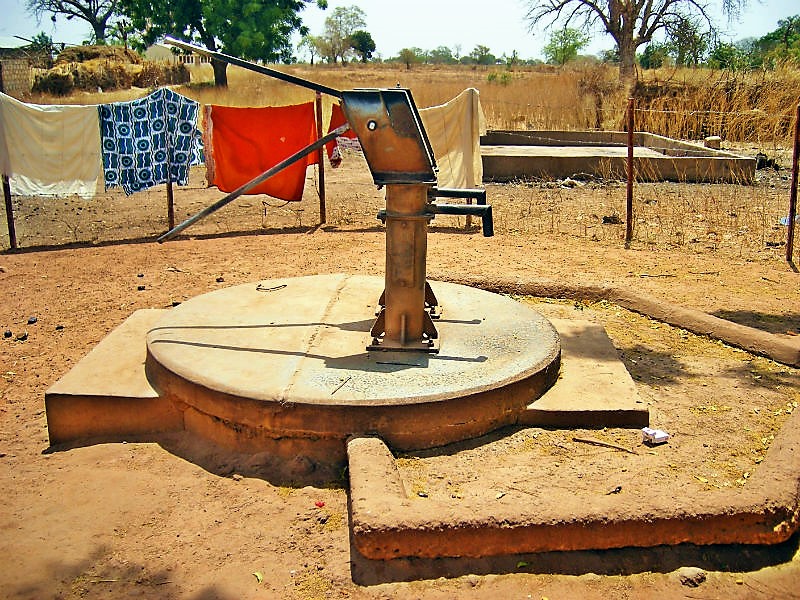
Human-powered pumps mainly suit small, rural communities with limited access to power sources, financial resources and rather low water requirements. Many different human-powered pump types have been developed, suiting a broad variety of local conditions. However, all human-powered pumps, particularly the low-cost options, require very frequent maintenance. A community operating a human-powered pump has to be able to find a way to organise O&M. Also, cultural acceptance might obstruct the establishment of a human-powered pump-based water supply system (e.g. foot pumps are not culturally accepted everywhere) (SMET & WIJK 2002).
All in all, human-powered pumps are a very promising water-lifting technique and capable of significantly improving a water supply system and, hence, the livelihood of a local community.
Water Lifting
This comprehensive manual presents different pumps and water lifting techniques and elaborates on technology choice and the role of the institutional framework.
BAUMANN, E. (2000): Water Lifting. (= Series of Manuals on Drinking Water Supply , 7 ). St. Gallen: Swiss Centre for Development Cooperation in Technology and Management (SKAT) URL [Accessed: 08.03.2019] PDFLow-cost Hand Pumps
This guidance note points out the strengths and limitations of a number of low cost pumps. It provides an overview of the application, technical details, materials used, installation and maintenance, manufacturing requirements and costs of several low cost pumps, including information on the numbers installed and locations.
BAUMANN, E. (2011): Low-cost Hand Pumps. St. Gallen: Rural Water Supply Network (RWSN) URL [Accessed: 08.03.2019] PDFLinking Technology Choice with Operation and Maintenance in the context of community water supply and sanitation. A reference Document for Planners and Project Staff
This document is addressed to planners and staff of water supply and sanitation projects on household and community level. The reader is guided through the main steps of informed choices regarding the main proven technologies for water supply, purification and water treatment at household and community level. Each technology is described in a small factsheet, regarding its functioning, actors and their roles, the main operation and maintenance (O&M) requirements and problems, which can occur.
BRIKKE, F. BREDERO, M. (2003): Linking Technology Choice with Operation and Maintenance in the context of community water supply and sanitation. A reference Document for Planners and Project Staff. Geneva: World Health Organization and IRC Water and Sanitation Centre URL [Accessed: 03.06.2018] PDFIntroductory Guide to Appropriate Solution for Water and Sanitation
WASH Technology Information Packages – for UNICEF WASH Programme and Supply Personnel
The Technology Information Packages (TIPs) provide technology selection guidelines for UNICEF WASH programme officers and partner organisations. They describe various different technologies and suggest how a programme using these technologies could be implemented.
MONTANEGRO, A. BAUMANN, E. SUTTON, S. ERPF, K. (2010): WASH Technology Information Packages – for UNICEF WASH Programme and Supply Personnel. Copenhagen: UNICEF URL [Accessed: 02.04.2012] PDFSmall Community Water Supplies: Technology, People and Partnership: Pumping - Chapter 9
This book provides a general introduction to a wide range of technologies. Among the topics covered are: planning and management of small water supplies, community water supplies in Central and Eastern European countries, water quality and quantity, integrated water resources management, artificial recharge, rainwater harvesting, spring water tapping, groundwater withdrawal, water lifting, surface water intake, water treatment, aeration, coagulation and flocculation, sedimentation, multi-stage filtration, desalination technology, disinfection, household level water treatment, technologies for arsenic and iron removal from ground water, and emergency and disaster water supply. Chapter 9: Pumping
SMET, J. ; WIJK, C. van (2002): Small Community Water Supplies: Technology, People and Partnership: Pumping - Chapter 9. The Hague: International Water and Sanitation Centre (IRC) URL [Accessed: 08.03.2019] PDFTreadle pumps in India
Deep-well hand piston pump including apron and drain in Wallalan, Upper Badibu District, Gambia
Compendium of Sanitation Systems and Technologies (Arabic)
This is the Arabic version of the Compendium of Sanitation Systems and Technologies. The Compendium gives a systematic overview on different sanitation systems and technologies and describes a wide range of available low-cost sanitation technologies.
TILLEY, E. ULRICH, L. LUETHI, C. REYMOND, P. SCHERTENLEIB, R. ZURBRUEGG, C. (2014): Compendium of Sanitation Systems and Technologies (Arabic). 2nd Revised Edition. Duebendorf, Switzerland: Swiss Federal Institute of Aquatic Science and Technology (Eawag) PDFCommunity Water Supply. The Handpump Option
This document presents conclusions of five years of work devoted to the assessment of available technology and management options for the wide-scale implementation of community water supply systems.
ARLOSOROFF, S. TSCHANNERL, G. GREY, D. JOURNEY, W. KARP, A. LANGENEFFER, O. ROCHE, R. (1987): Community Water Supply. The Handpump Option. Washington D.C.: THE WORLD BANK URL [Accessed: 02.04.2012]Water Lifting
This comprehensive manual presents different pumps and water lifting techniques and elaborates on technology choice and the role of the institutional framework.
BAUMANN, E. (2000): Water Lifting. (= Series of Manuals on Drinking Water Supply , 7 ). St. Gallen: Swiss Centre for Development Cooperation in Technology and Management (SKAT) URL [Accessed: 08.03.2019] PDFLow-cost Hand Pumps
This guidance note points out the strengths and limitations of a number of low cost pumps. It provides an overview of the application, technical details, materials used, installation and maintenance, manufacturing requirements and costs of several low cost pumps, including information on the numbers installed and locations.
BAUMANN, E. (2011): Low-cost Hand Pumps. St. Gallen: Rural Water Supply Network (RWSN) URL [Accessed: 08.03.2019] PDFTechnology Options – Handpumps, Mechanised Pumps and Surface Water
A wide range of different hand pump models is presented. For each model, pictures, schemes and detailed descriptions including information on materials, manufacturing, maintenance and technical performance is provided.
BAUMANN, E. ERPF, K. (2005): Technology Options – Handpumps, Mechanised Pumps and Surface Water. St. Gallen: Rural Water Supply Network (RWSN) URL [Accessed: 08.03.2019] PDFLinking Technology Choice with Operation and Maintenance in the context of community water supply and sanitation. A reference Document for Planners and Project Staff
This document is addressed to planners and staff of water supply and sanitation projects on household and community level. The reader is guided through the main steps of informed choices regarding the main proven technologies for water supply, purification and water treatment at household and community level. Each technology is described in a small factsheet, regarding its functioning, actors and their roles, the main operation and maintenance (O&M) requirements and problems, which can occur.
BRIKKE, F. BREDERO, M. (2003): Linking Technology Choice with Operation and Maintenance in the context of community water supply and sanitation. A reference Document for Planners and Project Staff. Geneva: World Health Organization and IRC Water and Sanitation Centre URL [Accessed: 03.06.2018] PDFZambia - National Guidelines for Sustainable Operation and Maintenance of Hand Pumps in Rural Areas
The Ministry of Local Government and Housing, in consultation and collaboration with key stakeholders, has formulated National Guidelines to improve the utilisation of water resources on a sustainable basis through effective O&M. These guidelines are based on the experiences of implementation of rural water supply projects in Zambia.
MLGH (2007): Zambia - National Guidelines for Sustainable Operation and Maintenance of Hand Pumps in Rural Areas. Zambia: Ministry of Local Government and Housing (MLGH) URL [Accessed: 08.03.2019] PDFWASH Technology Information Packages – for UNICEF WASH Programme and Supply Personnel
The Technology Information Packages (TIPs) provide technology selection guidelines for UNICEF WASH programme officers and partner organisations. They describe various different technologies and suggest how a programme using these technologies could be implemented.
MONTANEGRO, A. BAUMANN, E. SUTTON, S. ERPF, K. (2010): WASH Technology Information Packages – for UNICEF WASH Programme and Supply Personnel. Copenhagen: UNICEF URL [Accessed: 02.04.2012] PDFSmart Water Solutions. Examples of Innovative, Low-cost Technologies for Wells, Pumps, Storage, Irrigation and Water Treatment
This booklet on water technologies gives examples of innovations such as the use of sunlight to purify water, effective low-cost water filters, low-cost drip irrigation and locally produced hand pumps that are five times cheaper than imported pumps.
NWP (2006): Smart Water Solutions. Examples of Innovative, Low-cost Technologies for Wells, Pumps, Storage, Irrigation and Water Treatment. The Hague: Netherlands Water Partnership (NWP) URL [Accessed: 02.04.2012] PDFSmall Community Water Supplies: Technology, People and Partnership: Technologies for Arsenic Removal - Chapter 23
This book provides a general introduction to a wide range of technologies. Among the topics covered are: planning and management of small water supplies, community water supplies in Central and Eastern European countries, water quality and quantity, integrated water resources management, artificial recharge, rainwater harvesting, spring water tapping, groundwater withdrawal, water lifting, surface water intake, water treatment, aeration, coagulation and flocculation, sedimentation, multi-stage filtration, desalination technology, disinfection, household level water treatment, technologies for arsenic and iron removal from ground water, and emergency and disaster water supply. Chapter 23: Technologies for Arsenic Removal
SMET, J. ; WIJK, C. van (2002): Small Community Water Supplies: Technology, People and Partnership: Technologies for Arsenic Removal - Chapter 23. The Hague: International Water and Sanitation Centre (IRC) URL [Accessed: 08.03.2019] PDFSmall Community Water Supplies: Technology, People and Partnership: Pumping - Chapter 9
This book provides a general introduction to a wide range of technologies. Among the topics covered are: planning and management of small water supplies, community water supplies in Central and Eastern European countries, water quality and quantity, integrated water resources management, artificial recharge, rainwater harvesting, spring water tapping, groundwater withdrawal, water lifting, surface water intake, water treatment, aeration, coagulation and flocculation, sedimentation, multi-stage filtration, desalination technology, disinfection, household level water treatment, technologies for arsenic and iron removal from ground water, and emergency and disaster water supply. Chapter 9: Pumping
SMET, J. ; WIJK, C. van (2002): Small Community Water Supplies: Technology, People and Partnership: Pumping - Chapter 9. The Hague: International Water and Sanitation Centre (IRC) URL [Accessed: 08.03.2019] PDFTools for Assessing the O&M Status of Water Supply and Sanitation in Developing Countries
Problems with the operation and maintenance of water supply and sanitation have long been recognised as key constraints to the sustainability of these services. In order to address these problems in both urban and rural areas of developing countries, this document proposes a framework for management and tools for assessing the status of operation and maintenance (O&M) through measurement and evaluation of performance.
WHO (2000): Tools for Assessing the O&M Status of Water Supply and Sanitation in Developing Countries. Geneva: World Health Organization (WHO) URL [Accessed: 02.04.2012] PDFSocial adoption of groundwater pumping technology and the development of groundwater cultures. Governance at the point of abstraction
This thematic paper examines the historic and ongoing development of water lifting technologies and the governance problems and solutions that have arisen from controlled or uncontrolled groundwater abstraction. It also examines legislation to improved pump efficiency and the economics and life cycle costing of borehole pumps.
FAO GEF IAH IHP World Bank (2012): Social adoption of groundwater pumping technology and the development of groundwater cultures. Governance at the point of abstraction. FAO URL [Accessed: 08.04.2013] PDFSurvey on social economic and agronomic impact of the installation of the Swiss Concrete Pedal Pump in Tanzania. Report
To measure the impact of the pedal pump on the farmers’ life in Tanzania, a survey has been carried out in Magoma, a village of Korogwe District, where the pumps have been implanted by the Swiss-based NGO W3W.
FALCOZ, C. SEUROT, E. (2009): Survey on social economic and agronomic impact of the installation of the Swiss Concrete Pedal Pump in Tanzania. Report. Morogoro: : ENSAIA, Engineering Schoof of Agronomy, Nancy PDFImpact of Treadle Pump Irrigation Technology on Smallholder Poverty and Food Security in Malawi. A Case Study of Blantyre and Mchinji Districts
This case study analyses the impact of the treadle pump on smallholder poverty and food security in Malawi.
MANGISONI, J.H. (2006): Impact of Treadle Pump Irrigation Technology on Smallholder Poverty and Food Security in Malawi. A Case Study of Blantyre and Mchinji Districts. Lilongwe: University of Malawi URL [Accessed: 08.03.2019] PDFInterAide Support to Operation and Maintenance of Rural Water Supplies in Malawi in 2008
InterAide started a new O&M project in 2008 in three different districts located in the central region of Malawi. This report provides a description of the project, including the financial and human resource inputs.
SAINT MELOIR, B. de (2009): InterAide Support to Operation and Maintenance of Rural Water Supplies in Malawi in 2008. St. Gallen: Rural Water Supply Network (RWSN) URL [Accessed: 08.03.2019] PDFLow-cost Pump Alternatives for Rural Communities in Honduras
This report presents advantages and limitations of two types of low-cost pumps - the EMAS Flexi and the Rope Pump - used in several rural communities in Honduras, considering the users’ perspectives
WSP (2004): Low-cost Pump Alternatives for Rural Communities in Honduras. Meeting Demand for Access to Safe Drinking Water. Lima: Water and Sanitation Program (WSP). URL [Accessed: 02.04.2012] PDFThe Rope Pump Concept
This document contains a general guide for local Rope Pump manufacture. It addresses readers interested in this appropriate technology for water lifting that consider introducing the Rope Pump locally. Only generic features of the Rope Pump Concept are explained and hints for successful pump production are given.
ERPF, K. (2005): The Rope Pump Concept. St. Gallen: Rural Water Supply Network (RWSN) URL [Accessed: 08.03.2019] PDFSealing a borehole with a sanitary seal
This poster is part of the series of Water, Sanitation and Hygiene posters designed by the Water, Engineering and Development Center of Loughborough University.
SKINNER, B.H. CHATTERTON, K. SHAW, R. (2013): Sealing a borehole with a sanitary seal . Poster. (= WEDC Posters , 5 ). London: Water, Engineering and Development Center (WEDC) URL [Accessed: 28.08.2013] PDFDrainage from Water Points
This poster is part of the series of Water, Sanitation and Hygiene posters designed by the Water, Engineering and Development Center of Loughborough University.
SKINNER, B.H. CHATTERTON, K. SHAW, R. (2013): Drainage from Water Points. Poster. (= WEDC Posters , 7 ). London: Water, Engineering and Development Center (WEDC) URL [Accessed: 28.08.2013] PDFA Water Handbook
The Water Handbook is the result of wide collaboration within UNICEF. It provides a broad overview of state-of-the-art programming for water management, protection and supply.
UNICEF (1999): A Water Handbook. (= Water, Environment and Sanitation Technical Guidelines , 2 ). New York: United Nations Children’s Fund (UNICEF) URL [Accessed: 08.03.2019] PDFHandpump Technologies
The Rural Water Supply Network is a global knowledge network for rural water supply technologies and approaches. The website provides many excellent publications on various topics on rural development, particularly on hand pumping technologies. This section presents an overview of the different manual pumps for drinking water.
Water lifting devices
The Food and Agriculture Organisation of the United Nations (FAO) compiled a very comprehensive publication on water-lifting devices. Its purpose is to provide a basis for comparing and choosing between all present options for lifting irrigation water on small and medium sized land-holdings.
Summary of EMAS technologies
EMAS is a Mobile School for Water and Sanitation based in Bolivia, and run by Wolfgang Eloy Buchner. Many videos are provided showing in detail how EMAS pumps can be constructed.
Constructing a Water Well Hand Pump
Agua: yaku presents a simple and inexpensive method for constructing a hand pump.
Rope Pump Part 2
In this video, the principle of the rope pump is explained illustratively. Also, it elaborates on the reason why organisations make villagers pay for pumps instead of donating them.
IDEI, India, Low-cost treadle pumps for irrigation - Ashden Award winner
Low-cost treadle pumps for irrigation can improve the livelihood of communities significantly. This video introduces a project, which promotes the installation and use of treadle pumps in Uttar Pradesh, India.


